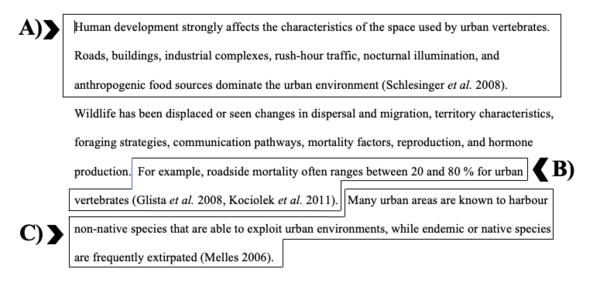Organizing/Transitions
Transitions
a) Have a clear topic sentence. Make sure that the first sentence of your paragraph clearly captures the main point of your paragraph. This establishes the topic of the paragraph and sets up the reader's expectations.
- In the example excerpted from Garber (2012) below, the first sentence of the paragraph is the topic sentence. This sentence clearly introduces the topic and establishes what is going to be discussed throughout the paragraph (i.e., how human development impacts various aspects of the environment that “urban vertebrates” use.)
b) Provide evidence to fully support the main point. Each sentence in the paragraph should expand upon or support the topic sentence.
- In the excerpt below, the author uses an example to provide concrete evidence to support the main point of the paragraph.
c) The relationship between the topic sentence and the concluding sentence should be clear. If not, it is possible that the purpose of the paragraph may have changed midway through. If this happens, consider rewriting the topic sentence to reflect what the paragraph actually does, or breaking the paragraph into smaller parts
- In the particular example below, the author concludes the paragraph by clearly connecting back to and emphasizing the initial point in the first sentence.
Figure 1. Adapted from Philipp Garber, Urban Vertebrate Ecology of the Pacific Northwest, with Recommendations for Wildlife Stewardship at UBC Vancouver (Vancouver: University of British Columbia, 2012). http://dx.doi.org/10.14288/1.0108522.
